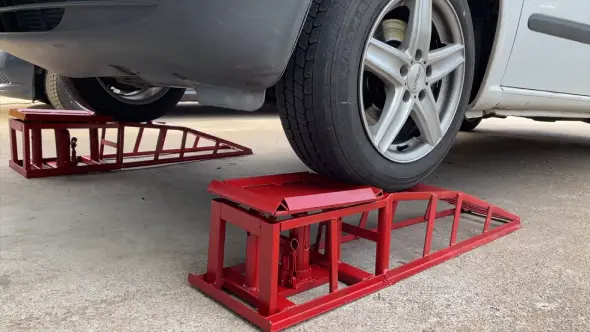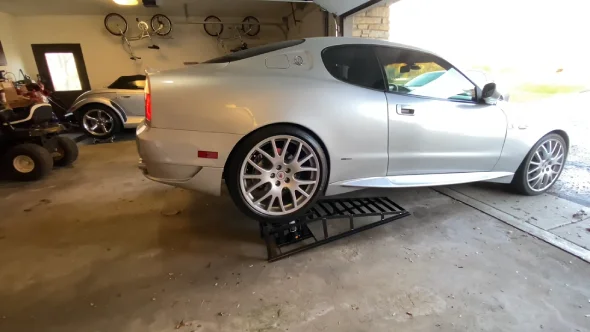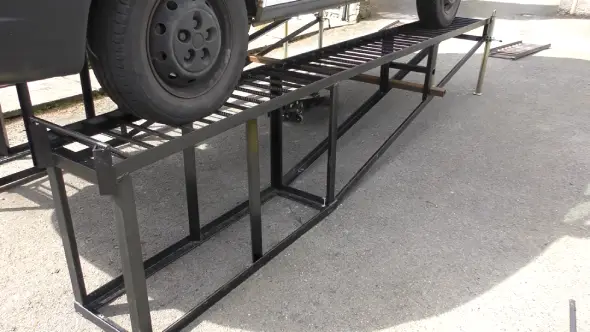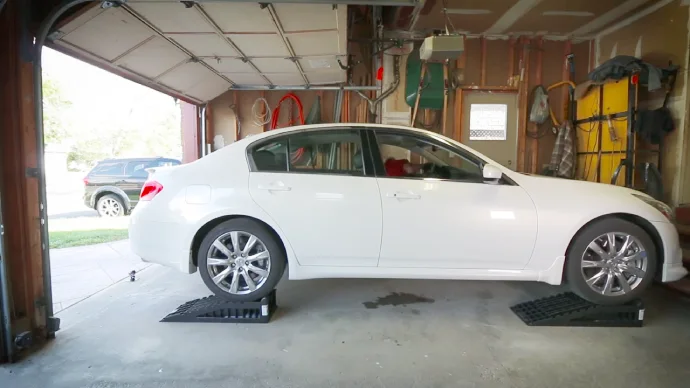Last Updated on March 23, 2023
Have you ever wanted to work on your car but weren’t sure you could lift a car on 4-car ramps? Using four-car ramps to lift a vehicle is a safe and quick way to work on the undercarriage. But you should always choose the right ramp based on the size of your car, as well as terrain, weight capacity, and surface.
After you’ve decided, ensure the ramps are in the right place to ensure a stable platform and a safe working environment. Before hoisting the car or placing anything underneath it, double-check that all 4 ramps are firmly in place.
With these simple steps covered, your car will be ready for repairs without you having to worry about its safety. This article will help you decide on the right ramps, position them correctly, and make sure your vehicle is secure before you start working.
How Can You Lift a Car on 4 Car Ramps: Easy Method

Lifting a car onto four-car ramps is a vital skill to know, as it allows you to safely access your vehicle’s underbody for oil changes and other repairs. To do this safely and correctly, it is important to understand the steps involved in lifting a car on 4 car ramps.
By following these instructions, you can ensure that your vehicle is securely lifted without any risks of slips or falls.
Step 01: Choose the Right Ramps
When lifting a car on 4 car ramps, it is crucial to choose ramps that are rated to support the weight of your vehicle. This is because if the ramp is not rated for the necessary load capacity, it could cause catastrophe and serious injury or damage to both you and your vehicle.
You should check the owner’s manual or contact the manufacturer to determine the total weight of your car. There are several other factors you want to consider when choosing car ramps.
- Look at how wide they are since narrower ramps make it difficult to drive up them.
- Find out what material they are made from, as this can affect their strength, durability, and grip.
- Check if they feature any safety features such as anti-slip or safety straps that can provide an extra layer of security while using them.
Step 02: Position the Ramps
The next step involves positioning the car ramps before pushing your vehicle onto them. Ensure that your car is parked on a flat surface and that each ramp is centered with one of the front tires before putting any weight on them.
Also, ensure that all four ramps are aligned straight so that it’s easier for your vehicle to drive over them without any issues. Once in place, carefully push the wheels towards them until they meet the edge of one ramp, then stop there so that you don’t put too much pressure on them just yet.
Step 03: Move The Wheels
Once all four ramps have been positioned correctly underneath one of your front tires, turn the steering wheel. Push forward slowly until both tires are securely placed on top of two sets of ramps, with both front wheels facing straight ahead.
This will help ensure an even weight distribution across all four car ramps, reducing any potential risks while driving or lifting up your car onto them.
Step 04: Drive Onto the Ramps
When driving onto ramps, it is important to start with the engine running and the car in gear. Carefully drive forward until both front tires are completely on the ramp. Keep an eye on the placement of the front wheels. They must stay centered for stability.
Once that has been accomplished, use a floor jack to raise the back end and safely secure it onto two more ramps. Adopting this approach helps guarantee a safe experience when using ramps by mitigating any chances of slipping off or rolling down from one side.
Step 05: Secure The Car
Once all four tires rest comfortably on each ramp, securing the vehicle by using its emergency brake is essential. Doing this will prevent movement as you lift or service your car.
Also, wheel chocks should be placed behind the rear wheels as a security measure against any possible rolling while servicing your vehicle. You can put them directly behind each tire or between them and a nearby curb, wall, or solid surface that will provide enough support for your safety.
Are Car Ramps Better Than Jacks?

Car ramps can be a safer alternative to using jack stands for lifting your car. While jack stands to provide more stability, they are not as safe for the average user since there is a risk of the car toppling over if the holds are not secure and level.
On the other hand, 4 car ramps offer a much simpler solution as there is no need to lift the entire car up with a jack. Only drive up onto the ramps until it reaches a certain height. Furthermore, when using ramps, there is no risk of it toppling over as the vehicle is already propped up securely on steady ground.
Regarding safety considerations, most car ramps are designed with non-skid surfaces that ensure greater ramp and surface friction. This makes them resistant to slipping even in moist environments.
While jacks require regular maintenance and inspection for proper functioning, car ramps usually don’t need any such thing. This makes them both easier to use and maintain.
How High Do Car Ramps Go?
The height of car ramps varies widely depending on their model or design. Some models can fit cars as low as three to five inches, while others can reach heights up to 10.5 inches or more.
Generally speaking, an optimal height for most cars ranges from 6 to 10 inches off the ground when using four car ramps.
This allows for sufficient clearance underneath so you can easily inspect or work on your vehicle without worrying about bumping your head on its underside or damaging other components due to insufficient clearance.
How Much Weight Can Car Ramps Hold?

Car ramps are generally made from metal materials like steel, making them incredibly strong and able to hold heavy loads easily.
Most metal ramps have a capacity ranging from 1,500 to 2,000 pounds which is more than enough weight capacity for most personal vehicles like sedans or compact cars but may not be suitable for larger vehicles like trucks or SUVs (especially those weighing more than 4,000 pounds).
If you use 4 metal ramps for cars, you should be able to lift a car weighing up to 4,000 pounds without any difficulties. But again, it is essential to remember that some car ramps may have lower weight capacities than others, and thus they may not be suitable for heavier vehicles.
And one should also consider that jack stands still provide stronger supports compared to most car ramp designs. Thus they remain the better option if you need higher rigidity when working on heavier vehicles or lifting heavier components like transmissions.
How Long Can You Leave a Car on Ramps?
Most modern-day car ramps are designed so that you can leave your vehicle propped up on them indefinitely (so long as it’s placed securely). Whether you use four ramps or just two, as long as you secure your vehicle properly and take safety precautions, it won’t matter.
As mentioned before, these high-quality and durable materials make it possible for users to trust their stability even after extended periods of time. The ramp and surface are sufficiently frictional, so you will not have to worry about your vehicle slipping or toppling from underneath.
But, if you’re using damaged ramps (which always present an increased risk), you shouldn’t leave your vehicle propped up indefinitely since bad conditions often result in problems like slips or collapses if used for too long without proper maintenance/inspection beforehand.
Experience Faster and Safer Automotive Repairs with Car Ramps
Using car ramps to lift your vehicle is a safer, faster, and more efficient way to diagnose or repair it. In most cases, lifting the car up with ramps instead of jacks and stands can shave off considerable time by simplifying the process and ensuring a reliable hold without fear of unsteadiness or shifting weight during repairs.
Taking a few extra minutes to ensure that the right size ramps are used for the car type, positioning them correctly in front of each wheel, and securing both the vehicle and its load will render safe and successful results. With these precautions in place, you can confidently take advantage of this time-saving tool.
